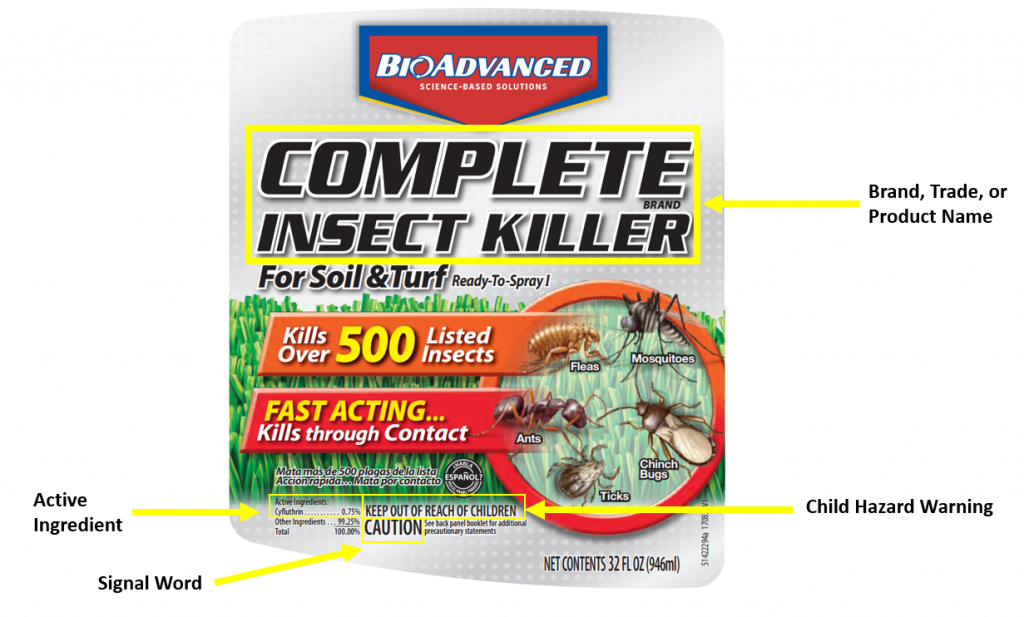Pesticides can be helpful tools in the home landscape and garden, helping to protect fruits, vegetables, and landscape plants from pests. While pesticides can be valuable tools in controlling pests, their improper use can pose risks to human health, beneficial organisms, and the environment. One crucial aspect of responsible pesticide use is understanding and interpreting the pesticide label. The label provides information on how to mix, apply, store, and dispose of a pesticide product to ensure the safety of the user and the environment.
First, it’s important to recognize what a pesticide is. A pesticide is a chemical substance or mixture used to kill or repel pests. Pests can include insects, weeds, plant pathogens, nematodes, mold, nuisance animals, and other organisms that can injury crops, plants, structures, or cause harm to human health. If you are unsure whether a product is considered a pesticide or not, the label will have an Environmental Protection Agency (EPA) number listed. This number is the EPA’s stamp of approval for the product to be sold and used as a pesticide (Figure 1). In the example shown in Figure 1, the EPA registration number is found on the back page of the pesticide label.

A pesticide label is the information on or attached to the pesticide container and is more than just a piece of paper. This document is a legal document. If you’ve contacted your local Extension office for pest control assistance, you’ve likely heard “follow the label – the label is the law” repeatedly. That is because the label is a contract between the product manufacturer, the Environmental Protection Agency (EPA), and the end user.
What information does the label contain?
Brand or Trade Name: The brand, trade, or product name is used to identify and market the product. It is found on the front panel of the pesticide label. For example, in Figure 2, the brand name of the pesticide is “Complete Insect Killer”. Different manufacturers may use different brand names to market products, even if the same pesticide active ingredient is used.
Active Ingredient: The active ingredient is the chemical that is responsible for killing, repelling, or controlling the target pest. The front panel of the label identifies the name and percentage weight of each active ingredient.
Child Hazard Warning: The front panel of every pesticide label must have the statement “KEEP OUT OF REACH OF CHILDREN” due to poisoning being a major cause of injury to children.
Signal Word: A pesticide label must also display a signal word on the front panel of the label to identify the relative toxicity of the product. Since all pesticides are poisons to some extent, it’s important to note that they do pose some risk. The signal word is based on the entire contents of the product, not just the active ingredients. Signal words are:
- DANGER: Highly toxic
- WARNING: Moderately toxic
- CAUTION: Slightly toxic

Personal Protective Equipment (PPE): The type of clothing that must be worn during the handling mixing process to protect the applicator from harm.
Statement of Practical Treatment: The statement of practical treatment or first aid statement, describes what to do if a person is exposed to the pesticide.
Directions for Use: This section of the label is the bulk of a pesticide label. This section provides detailed instructions on how to correctly apply the pesticide, including the site where the product may be used, application method, amount of pesticide that should be applied, timing of application, and frequency. It will also contain information on restrictions (if any) on product use including weather, time of day, season of year, contamination of sensitive areas, etc. Applying a pesticide to a site not listed on its label is illegal.
Storage and Disposal: Each pesticide has general storage and disposal instructions. Most pesticide labels will contain a general statement to the effect of “do not contaminate, water, food, or feed by storage, disposal, or cleaning of equipment” and “store in original containers only”. This section of the label provides guidance on how to store the product safely, including temperature requirements, shelf-life, and precautions to prevent contamination. It also outlines guidelines for disposing of unused pesticides or empty containers to prevent environmental harm.
Pesticides can be a valuable tool if used correctly. The first step in using a pesticide safely is to read the product label to learn about how the product may be used. For more information on understanding pesticide labels or for assistance with interpretation, please contact your local Extension Office.
- Explore Blackberry Production at the 2025 Blackberry Field Day - June 5, 2025
- Barefoot Beware: Lawn Burweed! - April 21, 2025
- The Good Guys: Beneficial Insects in Your Garden - March 13, 2025
